Malinithan
Malinithan is an archaeological site which consists of ruins of a Hindu temple of the early medieval period on the northern bank of the Brahmaputra River in the Indian state of Arunachal Pradesh. The archaeological studies of the ruins indicate that the temple was built with granite stones during the period of Hinduism influence in the region. It was built by Chutia kings in the 13th-14th century.[1][2][3][4][5] This was the period when the Chutia kings had started setting Brahmins in different areas of their kingdom offering them land grants.[6]Kechai-Khaiti, a tribal goddess found among the Bodo-kachari groups[7][8][9][10][11][12] is the chief deity who was worshipped in the ruined temple. The location of a narrow stream named Akashiganga similar to the site of Tamreswari and Bura-Buri Temples of Sadiya indicates that sacrifices were once performed in the temple.
| Malinithan | |
|---|---|
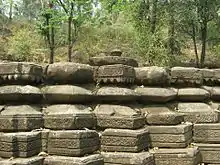 Ruins of Malinithan temple | |
| Religion | |
| Affiliation | Hinduism |
| District | Lower Siang district |
| Location | |
| Location | Likabali |
| State | Arunachal Pradesh |
| Country | India |
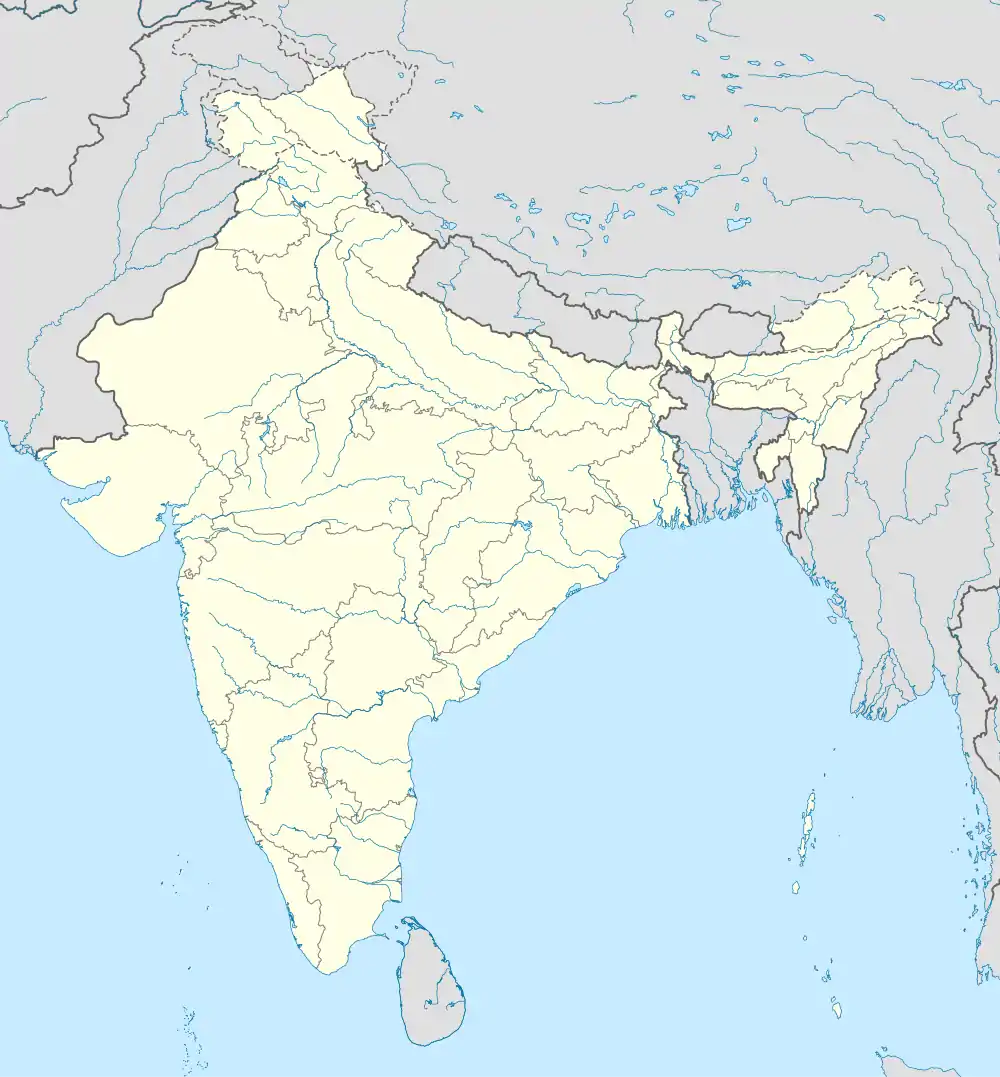 Malinithan in Likabali | |
| Geographic coordinates | 27°39′24″N 94°42′21″E |
| Architecture | |
| Creator | Chutia kings |
| Completed | 13th-14th century |
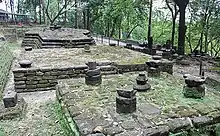
| Part of a series on the |
| History of Assam |
|---|
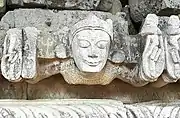 |
| Categories |
|
Location
The Malinithan archaeological site is located at the base of the Siang mountains in the Likabali town and a sub-division of the Lower Siang district of Arunachal Pradesh.[6][13] It is situated on a hill that rises to a height of 21 metres (69 ft), which affords a commanding view of the plains around it and of the Brahmaputra River.[14]
Legend
A legend was implanted around the site in the 16th century, connecting the place to the mythological king of Bhishmaka (Lord of Vidarbha) of the epics.[15] The association of the legend with the place led to a widespread renaming of the region.[16]
As per the mythology constructed, when Krishna wanted to marry Rukmini, the daughter of King Bhishmaka of Vidarbha, he abducted her prior to her wedding with Shishupala. Krishna and Rukmini then travelled from Bhishmakanagar to Dwarka, stopping at Malinithan on the way over, where they were guests of Shiva and Durga, who were doing penance. Parvati, Shiva's consort, warmly welcoming her guests, presented them with garlands made of flowers plucked from her orchard.[17]
History
The archaeological finds at the site of sculptures of Durga, a Shiva linga and a bull, the mount of Shiva, relate to worship by people of the Shiva cult. Based on these, archaeologists have inferred that the Shakti cult was practised in the region. It was one of the three leading centers of Shaktism; the other two centers are stated to be Bhaghawati, the mother goddess at Gorehoga village in North Lakhimpur, and Tamresari in the east. The temple doesn't find any mention in the 10th-11th century Kalika Purana. From all archaeological evidences at the site, archaeologists have opined that the temple belonged to the 13th century. Stone mason marks found in Malinithan[5] were also found in sites of Sadiya like Tamreswari temple, Bura-buri, Padum pukhuri as well as other places like Nakshaparbat and Buroi.
Features
The archaeological excavations revealed a very well designed and carved plinth of a temple, of 8 feet (2.4 m) height, sculptures of deities and animals, designs of flowers, damaged columns and panels. Four sculptures of lions on two elephants were found at the four corners of the ruins of the temple.
Among the sculptures found at Malinthan, five notable ones carved out of granite stone are of Indra riding his mount Airavata, Kartikeya riding a peacock, Surya (Sun) riding a chariot, and Ganesha mounted over a mouse, and a large Nandi bull.[14] On the basis of the erotic Maithuna sculptures found here in different postures it is believed that tantricism prevailed here as a fertility rite of the primitive tribal people who held the "mother principal as the procreative power of nature".
The temple is carved entirely out of stone, a type of temple known as Asmamayai. Iron dowels discovered in the ruins of the stone temple which resemble the ones found in the Tamreswari temple of Sadiya shows that it was built by the same people.[18]
Gallery
 Malinithan Mother goddess sculpture
Malinithan Mother goddess sculpture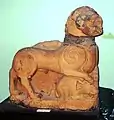 Gaja-singha of Malinithan
Gaja-singha of Malinithan Malinithan Shiva sculpture
Malinithan Shiva sculpture Malinithan Kartika sculpture
Malinithan Kartika sculpture Malinithan Apsara sculpture
Malinithan Apsara sculpture
References
- Sarma, P.C.A study of the temple architecture of Assam from the Gupta period to the end of the Ahom rule: Chutiya architecture, p. 205
- Choudhury, R.D, Heritage of Architecture of Assam, p.5
- (Bose 1997:43)
- Sengupta, Gautam, Archeology in Northeast India, p.359
- Thakur, A.K, Pre-historic Archeological Remains of Arunachal Pradesh and People's perception: An Overview, p.6
- "Malini Than". Government of Arunachal Pradesh. Archived from the original on 12 May 2015. Retrieved 3 May 2015.
- Kechai Khati worshipped by Bodo-kacharis
- Rabhas worship Kechai-khati and celebrate the Kechai-khati festival once every year
- Kechai-khati festival of Rabhas
- The Tiwas, as well as the Koch, also worshipped Kechai Kati. The Koch general Gohain Kamal built temples dedicated to Kesai Khati in Khaspur for the Dehans who were Tiwa and Mech soldiers from Gobha, Nellie and Kabi.
- "There is at Sadiya a shrine of Kechai Khaiti the tutelar deity of the Kacharis, which the Dimasa rulers continued to worship even after the establishment of their rule in Cachar." (Bhattacharjee 1992:393)
- "The most famous temple of the Chutiyas was that of Kechaikhati, their primodial female deity.(Dutta 1985:49)
- "Likabali". Retrieved 3 May 2016.
- Sali 1998, p. 148.
- "Among many works of Śaṅkaradeva, the Rukmiṇiharaṇa, the poem of Rukmimi and Krishna, gained considerable popularity in the Sadiya area and influenced its regional identity construction. Rukmiṇī, in this poem, was a daughter of king Bhīṣmaka"(Shin 2020, p. 55)
- (Shin 2020:56): "Considering the wide popularity of the Rukmiṇīharaṇa among the people, especially as the staged performance, it is not surprising that many toponyms of the area were derived from this Vaiṣṇava legend and the legendary places associated with Bhīṣmaka were reproduced in the local landscape. For instance, Vidarbha, the name of the country, once ruled by Bhīṣmaka according to the Epics and Purāṇas and perhaps identical with Behar in Maharashtra, was applied to the area around Sadiya."
- Shin 2020, p. 56.
- Religious History of Arunachal Pradesh by Byomakesh Tripathy, p.354
Bibliography
- Sali, M. L. (1 January 1998). India-China Border Dispute: A Case Study of the Eastern Sector. APH Publishing. ISBN 978-81-7024-964-1.
- Bhattacharjee, J. B. (1992), "The Kachari (Dimasa) state formation", in Barpujari, H. K. (ed.), The Comprehensive History of Assam, vol. 2, Guwahati: Assam Publication Board, pp. 391–397
- Dutta, Sristidhar (1985), The Mataks and their Kingdom, Allahabad: Chugh Publications
- Shin, Jae-Eun (2020). "Descending from demons, ascending to kshatriyas: Genealogical claims and political process in pre-modern Northeast India, The Chutiyas and the Dimasas". The Indian Economic and Social History Review. 57 (1): 49–75. doi:10.1177/0019464619894134. S2CID 213213265.